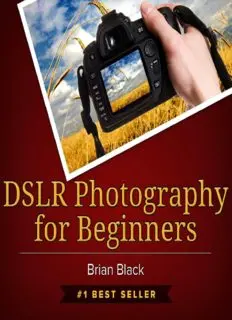
DSLR Photography for Beginners: Best Way to Learn Digital Photography, Master Your DSLR Camera & Improve Your Digital SLR Photography Skills PDF
Preview DSLR Photography for Beginners: Best Way to Learn Digital Photography, Master Your DSLR Camera & Improve Your Digital SLR Photography Skills
DSLR Photography for Beginners • The Right Way of Learning Digital SLR Photography • By Brian Black Copyright © 2013 Table of Contents Digital Photography Why SLR? Aperture: What Is It? Shutter Speed: What Difference Does it Make? ISO Sensitivity Specialized Lenses Telephoto Lens Wide-Angle Lens Lens Multiplication Factor Zoom Lens Wide-Angle Zoom Lens Telephoto Zoom Lens Superzoom Lens Prime Lens Macro (or Close-Up) Lens Fish-Eye Lens Tilt And Shift Lenses Composing the Picture: Light, Framing, Focus Lighting Framing Rule of Thirds Including Context Layers and Depth Focal Points Integrity and Wholeness Lines, Colors, Textures and Shapes Simplicity and Empty Space Eye Contact Focus Point of Focus Using All the Camera’s Focal Points Depth of Field Focus Modes Panning Lens Effects on Depth of Field Downloading and Storing Your Photos Using Graphic Design Software Conclusion Digital Photography Digital photography has become the standard today. Most cameras sold today are digital. Analog photography is on the way to disappearance except in a few niche applications. But what exactly is digital photography? In what ways is it better than analog photography? How did it earn its place of preeminence? All photography captures an image by focusing light reflected from something in the world through a lens and recording that image in a medium. With old- fashioned analog photography, the medium was a film with light-sensitive chemicals that darkened or changed color when struck by light. The film was then processed in a darkroom using various chemicals that caused the image to appear in a “negative” – with the colors reversed – and then light was beamed through the film onto light-sensitive paper which was also exposed to chemicals to produce a “print.” The process was time-consuming and included many points where mistakes were possible. It was expensive in terms of materials and labor both, but until the advent of digital photography, it was the only way that photographs could be taken, developed, and preserved. Instead of this analog process, digital photography focuses the light from the lens onto an array of electronic light sensors hooked up to a computer processing chip to create a digital image and store it in digital memory. The stored image can be seen immediately on the camera’s screen, transmitted to other devices for storage or further processing, and digitally published on the Internet. The advantages of digital over analog photography are enormous. There’s no danger of losing photographs by accidentally exposing film, or of making a mistake in the development process that ruins the photo forever. You can see the results of your efforts immediately, and know if you need to retake a shot, as opposed to waiting hours or days before the results are available. There’s no delay while the photos are processed; they can be checked at once. That means you don’t have to take as many shots in order to be reasonably sure of a good one, and in addition each photo you take costs essentially nothing – no film, no development chemicals, no printing paper or slide materials. Digital photography saves both time and money by making the process more efficient and less wasteful. You can make perfect copies of a digital photograph, whereas copies of analog photographs lose fidelity the more times copies of copies are made. Digital photographs are taken in exactly the format you will need for digital publication or for using the photos in a graphic design program. There’s no guesswork involved in moving from one medium to another, no wondering how a photo that looks great in an eight by ten glossy will appear when rendered into newsprint. What’s more, with digital photography there’s no need to worry about whether you’re using the right kind of film. You don’t need to have supplies of various speeds of film for different shooting conditions and purposes. Any type of image in any type of light can become a photo in your camera’s digital memory, provided it’s within the parameters your camera lens, aperture, and shutter speed can handle, one size fits all. Finally, digital photography allows some versatile automatic controls to be implemented for things like focusing and exposure control, some of which we’ll discuss in a bit.
